You may have heard of the Hindu city of Varanasi, which dates back to the 11th century B.C. It is known as the spiritual capital of India and attracts many Hindu pilgrims to the banks of the River Ganges. It has over 2,000 temples, including the Kashi Vishwanath temple, which is dedicated to the Hindu god Shiva. For many travelers, Varanasi is simply a destination for religious pilgrimage, but there are many more things to do in Varanasi.
1. Shivala Ghat 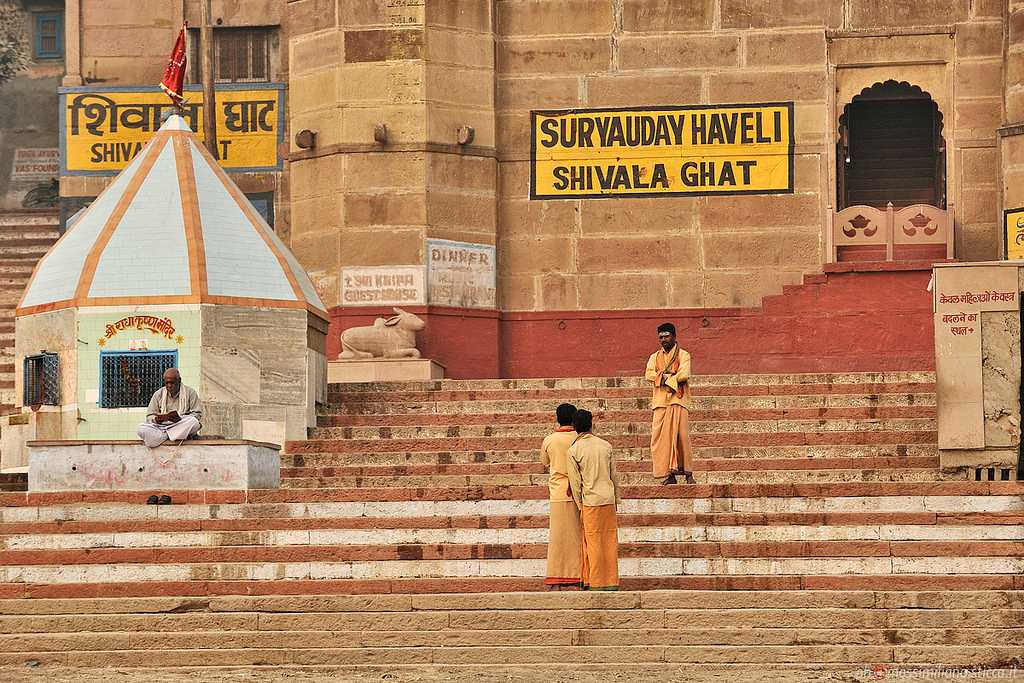
If you’re considering visiting holy city, you must do so during the month of April. The holy river flows through the city at the Ganga Ghats, 88 ghats to be exact. Most of these are used for bathing and puja ceremonies, with two remaining exclusively for cremations. The majority of ghats were rebuilt in the eighteenth century under Maratha patronage. If you want to see a spectacular show, visit the Dashashwamedh Ghat. There, you’ll see the famous Ganga Aarti, which includes fire and puja.
The Ghat is the biggest attraction in Varanasi, but there’s more to this holy city than the ghat. The Shiva Temple, which was built in the 19th century by a Nepalese king, is one of the city’s most important attractions. Aside from the temple, the Shiva colony is home to many monasteries, ashrams, and temples.
The city’s ghats are a great way to start the day. The famous Kevalgiri ghat is the most popular among South Indians and Bengalis. This ghat is home to a beautiful and ancient temple. The ancient temple here is home to three heritage shrines, including those of Sri Adishankaraycharya, Yamaditya, and Lakshminarayan.
If you have time, you should also take time to visit the Bharat Mata temple, which is dedicated to the goddess India. This temple was inaugurated by Mahatma Gandhi in 1936 and was the inspiration for the Indian war of independence. The temple also features a relief map of India carved on the marble, representing the entire country. You can visit the temple to see the magnificent relief map of the country.
2. Ramayana Temple 
The second largest temple in Varanasi is the Ekadash Rudra temple. Located on the banks of the sacred River Yamuna, it has two large halls and displays a highlight of the Ramayana. The temple features a carving of the sage Vasudevas, who married the beautiful Sita before embarking on a divine journey. Another temple worth visiting is Kashi Vishwanath, a Hindu temple dedicated to Lord Vishnu, the creator of the Indian concept of gods.
If you are coming from another part of the country, you can hire a cab to get to the temple from your hotel. Varanasi is very well connected by road. There are regular bus services that operate between the city and major cities. You can also hire a rickshaw, cab or auto and make your way to the temple. You can visit the Ramayana temple in Varanasi throughout the year, making it an ideal place to visit for religious or personal reasons.
The Kashi Vishvanath Temple is also close by, and is home to a large number of gurus and seers. The temple has many gurus and is also a place to pray and meditate. The temple is the most important place of worship in the area. A visit to Varanasi’s Ramayana temple is a wonderful way to start your spiritual journey. Book Maharajas Express
The Sankat Mochan Hanuman temple is another important Hindu temple in the city. People in India believe that offering a regular Holy Pooja will remove their obstacles. In particular, people with ill-placed Saturn should make their way to the temple to pray to the presiding deity. There are tens of thousands of devotees praying outside the temple, which is an impressive sight to behold.
Suggested Tour Packages
- Varanasi Tours
- Varanasi Spiritual Tour
- Varanasi Prayagraj Trip
- Varanasi Tour Packages
- Kashi Tour from Hyderabad
- 3 Days Varanasi Religious Tour
- Varanasi Tour with Luxury Hotel
- Varanasi City Tour with Ganga Aarti
3. Ganga Aarti Ceremony 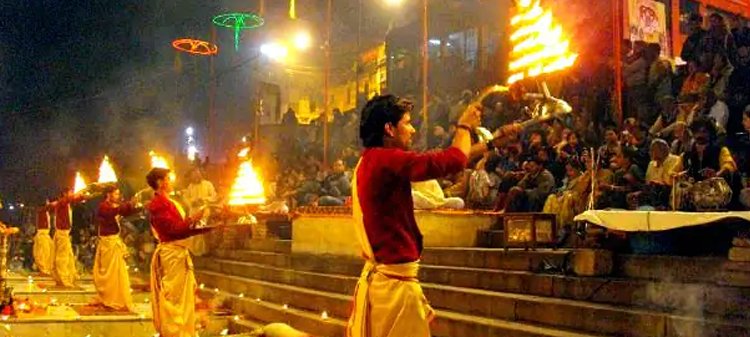
Witness the Ganga Aarti ceremony in Varanaasi, India. It is one of the most impressive religious rituals in the world and takes place every evening at sunset at the Dashaswamedh Ghat near the Kashi Vishwanath Temple. The performance is highly choreographed and consists of a series of rituals and chants, including the blowing of conch shells, ringing of bells, and clanging of brass cymbals. The ritual is also accompanied by the laying of flowers and incense sticks to please the River Goddess.
The Ganga Aarti ceremony takes place at several ghats in Varanasi. Dashashwamedh Ghat is the most famous, and Rajendra Prasad Ghat is located nearby. At sunset, the ceremony begins. Participants assemble on a raised platform where flowers, conch shells, incense sticks, prayer bells, and huge brass lamps are placed.
A Hindu priest performs the Ganga Aarti ceremony. The ritual, which is as ancient as mythology, involves a mass offering to the Goddess Ganga. The ceremony takes place on the occasion of Ganga Dusshera, which falls in the calender year. According to legend, Goddess Ganga descended from heaven and changed into a river in order to wash the sins of King Bhagirath’s ancestors.
In the ghats along the river banks, Hindu priests perform Ganga Aarti. During the aarti, brass lamps are lit, and Hindus chant songs praising the Mother Ganga. During the aarti, devotees place their hands over the lamp and raise their palms to receive the Goddess’ blessing. Floating flowers and diyas are also offered to the Goddess as offerings.
4. Banarsi Paan 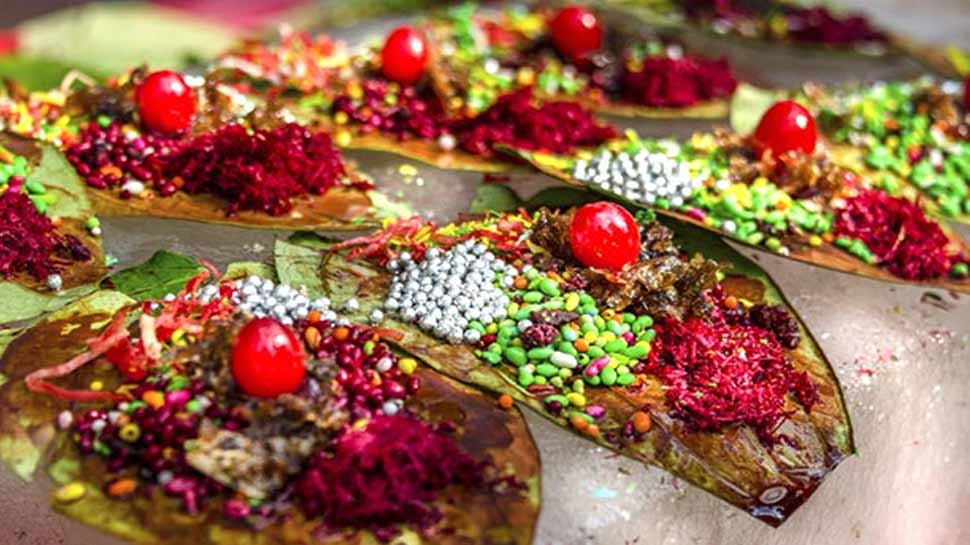
If you’re looking for authentic Banarsi Paan, you’ve come to the right place. This local delicacy is a popular breakfast choice and can be found at any restaurant and eatery in Varanasi. If you’re in a hurry, you can grab a snack in one of the city’s side streets. A kachori sabzi is a popular breakfast option and is available for as little as INR 15.
You can get a traditional version of the famous mouth freshener in Varanasi, or even order it online! This mouth freshener is made from a mixture of area nut and betel leaf, and is an absolute must try for any tourist visiting the city. It dates back thousands of years, and was popular in ancient and medieval India. In ancient India, a paneri, or saffron seller, would serve it to every household.
The betel leaf, or banarsi paan, is an Asian plant with medicinal properties. It is used as a mouth freshener and icebreaker throughout Asia. The betel leaf is a sacred plant and is mentioned in many Hindu epics. Hanuman’s garland was made of betel leaves in the Ramayana. If you’re looking for an authentic Banarsi Paan in Varanasi, be sure to visit the Dashaswamedh Ghat.
Another popular Varanasi Paan is the Choti Patti Paan. This local treat is made by wrapping a betel nut with a betel leaf. The resulting treat has a royal taste that has lasted since the days of the regal era. In fact, Banarsi Paan is so popular that even President Barack Obama has ordered it at his dinner! The Banarsi Paan is one of the best things to do in Varanasi at night.
5. Ramnagar Fort 
Ramnagar fort in Varanasi is a historic fortification in northern India. The fort is a sandstone structure that dates back to the eighteenth century and is built by king Balwant Singh. Its unique style and Mughal influence is evident throughout the fort. There are several inscriptions from the seventeenth century as well as a museum containing royal household items.
The fort is made of red sandstone and houses two temples, one dedicated to Lord Vishnu and the other to the famous poet Ved Vyasa. The poet is believed to be the author of the famous Mahabharata, the world’s longest poem. He lived in the fort for a while and had his temple built there. Various statues of Lord Vishnu and Ved Vyasa are displayed in the temples.
Visitors can view the ancient astronomical clock at the Saraswati Bhawan museum, located in the Ramnagar fort. There are numerous collections of rare pieces of art and antique weapons and armour. Some of the highlights are the ivory-carved elephant saddles, the astronomical clock, and the royal costumes. The museum is a must-visit for anyone visiting Varanasi.
A visit to the Ramnagar fort in Varansi should be done during October or during Dussehra festival. The fort will be alive with festivities and performances during these celebrations. The fort is accessible by boat during monsoon. The boat ride from Dashashwamedh Ghat is about an hour. The fort is located on an island, so visitors should arrive by boat to get a view of the surrounding area.
Suggested Tour Itineraries
- Golden Triangle Tour with Varanasi
- Golden Triangle Vacations from Kushinagar
- Golden Triangle Tour with Yoga at Rishikesh
- Golden Triangle Tour with Mathura Vrindavan
- Golden Triangle Tour with Udaipur and Varanasi
- Golden Triangle Tour with Lucknow and Bodhgaya
- Golden Triangle Tour with Khajuraho and Varanas
- Jaipur Tour Packages
6. Sarnath 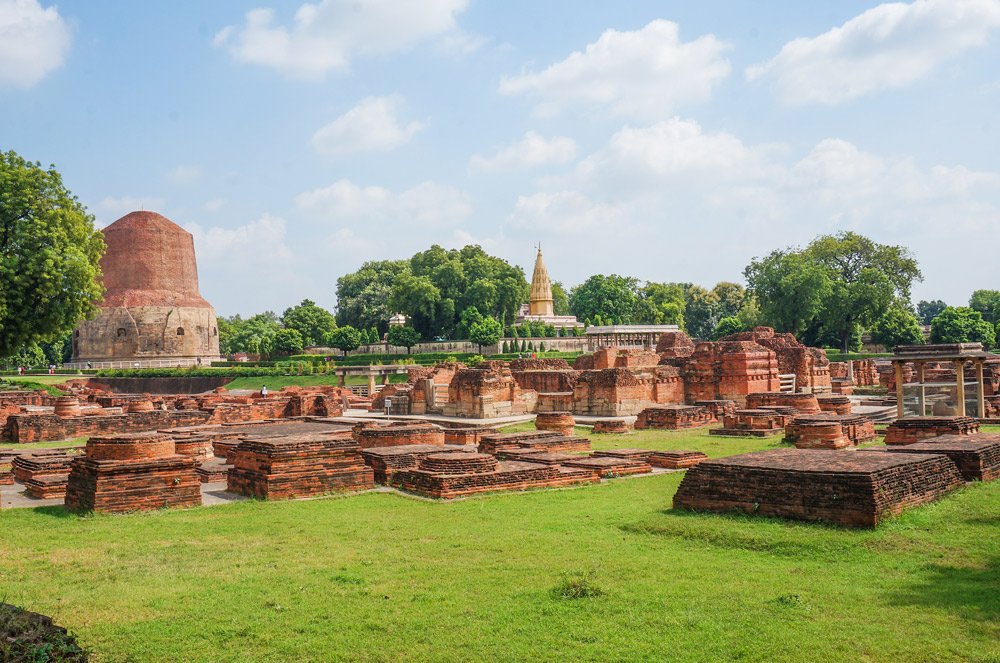
If you’ve ever heard of Sarnath, then you’ve probably heard of the ancient city. If you’re not familiar with the city, it’s located about 10 kilometers north of Varanasi in Uttar Pradesh. It’s also near the confluence of the Ganges and Varuna rivers. The first Dharma teaching of the Buddha took place here, and the Buddhist Sangha was born. This ancient city is a must-visit destination for any traveller to India.
The city of Sarnath dates back to the fifth century BCE, when the Buddha stayed here to preach the Dharma to his five companions. As the Buddha spread the Dharma, the number of holy men gathered in Sarnath grew to sixty. As time passed, many elite monks began to live and study in the area. The area became a learning center, known as the Hinayana. While the deer-king wanted to kill the Buddha, the local ruler allowed the Buddhist to stay in the city, resulting in the birth of the first monks.
While Sarnath is an important religious site, the city is also an important artistic site. During the Gupta period, from the fourth to the sixth century BCE, there was an explosion of artistic production in northern India. In Sarnath, the town grew into a center for the creation of Buddhist and Hindu art. Despite the recent boom in the popularity of the city, it still retains its traditional charm and has many ramifications for pilgrims.
7. Kashi Vishwanath Temple 
The Kashi Vishwanath Temple is a famous Hindu temple dedicated to Lord Shiva. Located in Varanasi, Uttar Pradesh, it is situated on the western bank of the holy river Ganga. It is one of the twelve Jyotirlingas, or sacred shrines. While many of the pilgrimages to Kashi Vishwanath are centered on its sanctity and its enchanting aura, others visit it for the spiritual benefits it provides to both the city and the country.
The temple complex is quadrangular in shape and consists of several small shrines and temples dedicated to the Lords. The temple is divided into three distinct regions by a spire over the Lord Vishwanath’s temple. There is also a gyana vapi (well of wisdom) between the mosque and the temple. The gyana vapi is believed to be the location where the Kashi Vishwanath idol is hidden.
The temple is also home to the Lord Shiva messengers, called the Shiva Ganas. The Ganas help the devotees during their final journey. As the Hindu god, Lord Shiva chants the salvation mantra in the ears of every visitor to Kashi. After the gyanvapi mosque closes for the night, other devotees may enter. However, aarti is not permitted when the king of Kashi is in the temple.
The temple is located in a congested part of town. Currently, the only way to reach the temple is to walk through a narrow gully flanked by buildings. The proposed corridor will increase the spiritual experience of pilgrims by providing direct visibility from the ghat to the temple. It will also allow the pilgrims to view the Jyotirlinga in its entire glory.
8. Dashashwamedh Ghat 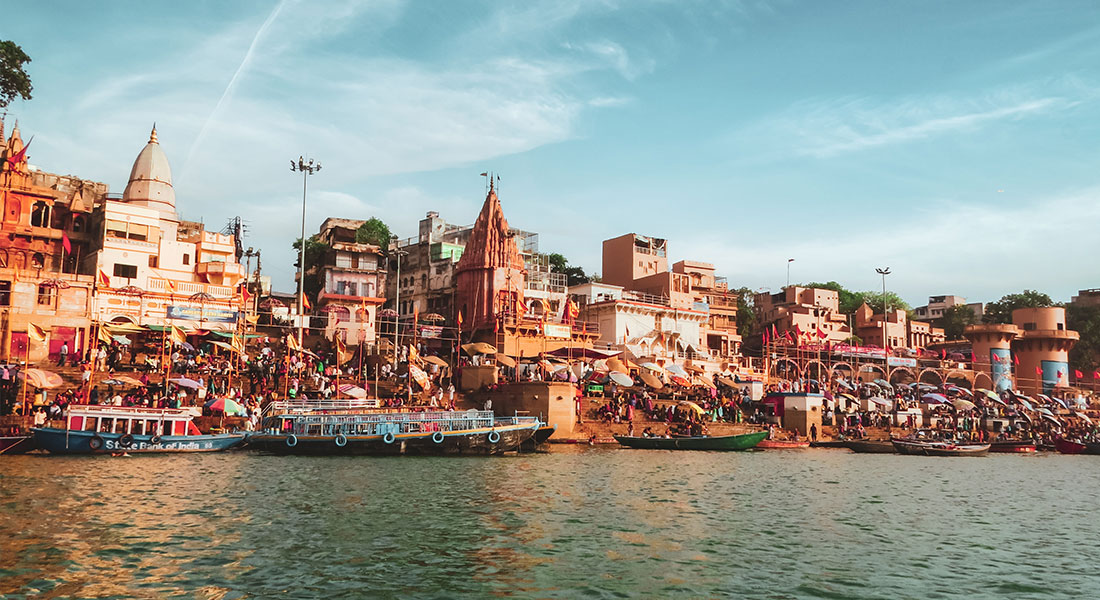
The main ghat of Varanasi, near the Vishwanath Temple, is the Dashashwamedh Ghat. This ghat is perhaps the most beautiful one in Varanasi. It is well worth a visit. Here are some things to know before you visit Dashashwamedh Ghat. Here are some tips to make your trip to Varanasi a memorable one:
Dashashwamedh Ghat is the oldest and busiest ghat in Varanasi. It is the site of the famous Ganga aarti. According to Hindu mythology, Lord Brahma created this ghat to welcome Lord Shiva and sacrificed ten horses at this ghat. Today, the ghat attracts large crowds, and pilgrims come to bathe in the holy Ganges.
While visiting Dashashwamedh Ghat, make sure you leave plenty of time to watch the Ganga Aarti Ceremony. This ceremony takes about 45 minutes, and thousands of devotees come to witness the ritual. The Ghat is also surrounded by Hindu temples. You can hire a boat to the ghat to watch the ritual. A local market near the Ghat is also a good place to shop.
In the second century, Bhara Shiva Naga rulers performed a ten-horse sacrifice. Every day, a group of priests performs the Agni Pooja dedicated to Lord Shiva, the River Ganges, and the entire universe. While here, you can also enjoy the colorful riverfront view. You can even see sadhus performing their religious activities. You may even come across some chanting.
Suggested Tours
- Jaipur Tour
- Taj Mahal Tour
- Delhi Tour Packages
- Agra Tour Packages
- Amritsar Tour Packages
- Wildlife Tour Packages
- Rajasthan Tour Packages
- Golden Triangle Tour Packages
9. Satynarayan Tulsi Manas Mandir 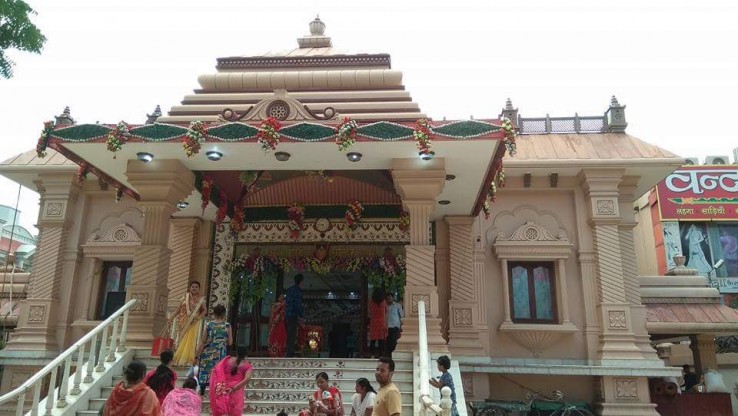
If you want to visit this holy temple, there are some tips you must keep in mind. There are several restrictions, including no cell phones, camera, or leather belt. The temple’s premise is small, and the only way to enter and exit is through a single door. You can also leave your offerings in the temple’s lockers. The UP government maintains the temple.
Workers at the temple perform similar tasks as other temple employees. The temple’s workers are alleged to not be paid minimum wages. A complaint filed in 1995 by Bhartiya Mazdoor Sangh alleges non-payment of minimum wages. The temple management received a notice from the Additional Labour Commissioner of Varanasi and later filed a writ petition in the Allahabad High Court.
The first Aarti of the day is performed every day before sunrise, allowing devotees to pray close to the lingam. The railing is removed and floral offerings are not made during this time. The Aarti lasts about 45 minutes. The first Aarti is followed by a long-lasting Abhishekam, with countless earthen lamps being immersed in the river. After the abhishekam, the lingam is again decorated with flowers.
10. The Scindia Ghat 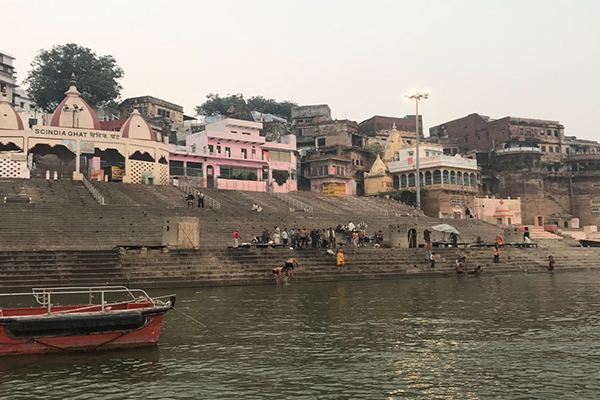
The scindia ghat in Varanasi is dedicated to Lord Shiva. Devotees throng the area early in the morning to pray to Shiva, the lord of the universe. It’s been over 150 years since the temple was submerged, and is now nearly underwater. Thousands of people converge here each morning for morning meditation.
In the area surrounding the ghat are many temples. The temple of Veereshwar was built in 1302, and is said to be the birthplace of the Hindu God Agni. The ghat has three rows of stone turrets, and is a popular site for meditation. Although there are numerous temples in the area, the ghat is the most popular one.
If you’re looking for a quiet place to pray, the Scindia Ghat is an excellent choice. The ghat borders Manikarnika, a Hindu cremation site, and is home to a tilted Shiva temple. The temple collapsed under its own weight, but it is still a great sight to see. It was constructed in 1830 by the Scindia family. Siddha Kshetra is above the ghat, and is where Hindus pray and propitiate to the Lord of all heroes.

